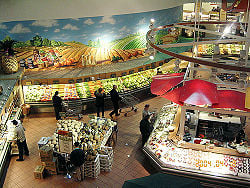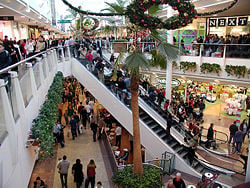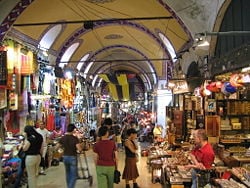Retailing
Retailing consists of the sale of goods or merchandise, from a fixed location such as a department store or kiosk, in small or individual lots for direct consumption by the purchaser.[1] Retailing may include subordinated services, such as delivery. Purchasers may be individuals or businesses. In commerce, a retailer buys goods or products in large quantities from manufacturers or importers, either directly or through a wholesaler, and then sells smaller quantities to the end-user. Retail establishments are often called shops or stores. Retailers are at the end of the supply chain. Manufacturing marketers see the process of retailing as a necessary part of their overall distribution strategy.
Shops may be on residential streets, shopping streets with few or no houses, or in a shopping center or mall, but are mostly found in the central business district. Shopping streets may be for pedestrians only. Sometimes a shopping street has a partial or full roof to protect customers from precipitation. Retailers often provided boardwalks in front of their stores to protect customers from the mud. Online retailing, also known as e-commerce is the latest form of non-shop retailing (cf. mail-order business).
Shopping generally refers to the act of buying products. Sometimes this is done to obtain necessities such as food and clothing; sometimes it is done as a recreational activity. Recreational shopping often involves window shopping (just looking, not buying) and browsing and does not always result in a purchase.
Most retailers have employees learn facing, a hyperreal tool used to create the look of a perfectly-stocked store even when it is not.
Etymology
Retail comes from the French word retaillier which refers to "cutting off, clip and divide" in terms of tailoring (1365). It first was recorded as a noun with the meaning of a "sale in small quantities" in 1433 (French). Its literal meaning for retail was to "cut off, shred, paring." Like the French, the word retail in both Dutch and German (detailhandel and Einzelhandel respectively) also refer to sale of small quantities or items.
Retail types
The term retailer is also applied where a service provider services the needs of a large number of individuals, such as with telephone or electric power. There are three major types of retailing. The first is the marketplace, a physical location where buyers and sellers converge. Usually this is done in town squares, sidewalks or designated streets and may involve the construction of temporary structures (market stalls). The second form is shop or store trading. Some shops use counter-service, where goods are out of reach of buyers, and must be obtained from the seller. This type of retail is common for small expensive items (e.g. jewelry) and controlled items like medicine and liquor. Self-service, where goods may be handled and examined prior to purchase, has become more common since the Twentieth Century. A third form of retail is virtual retail, where products are ordered via mail, telephone or online without having been examined physically but instead in a catalog, on television or on a website. Sometimes this kind of retailing replicates existing retail types such as online shops or virtual marketplaces such as Amazon.[2].
Marketplace
A Bazaar (Persian: بازار) is a permanent merchandising area, marketplace, or street of shops where goods and services are exchanged or sold. Originating from ancient Islamic civilizations, the bazaar is the precursor for the modern day supermarket, flea-market, and shopping mall, and has had a great influence on the economic development and centralization in modern cities around the world.
A supermarket is a departmentalized self-service retail store offering a wide variety of food products, such as meat, produce, dairy, and so forth, along with various household merchandise. It is larger in size and has a wider selection than a traditional grocery store. Supermarkets are generally situated near residential areas for easy access and maximum sales. In the 1920s the first supermarket opened in the United States, heralding in a new era of retail: self-service.
Stores
Buildings for retail have changed considerably over time. Market halls were constructed in the Middle Ages, which were essentially just covered marketplaces. The first shops in the modern sense used to deal with just one type of article, and usually adjoined the producer (baker, tailor, cobbler). In the nineteenth century, in France, arcades were invented, which were a street of several different shops, roofed over. counters, each dealing with a different kind of article was invented; it was called a department store. One of the novelties of the department store was the introduction of fixed prices, making haggling unnecessary, and browsing more enjoyable. This is commonly considered the birth of consumerism [3]. In cities, these were multi-story buildings which pioneered the escalator.
Today, a department store is a retail establishment which specializes in selling a wide range of products without a predominant merchandise line. The purpose of the department store is to cater to the needs and roles of all social classes. Department stores generally sell a wide variety of products including apparel, furniture, appliances, electronics, and additional select lines of products such as paint, hardware, toiletries, cosmetics, photographic equipment, jewelry, toys, and sporting goods. Certain department stores are further classified as discount stores, which commonly have central customer checkout areas, generally in the front area of the store, and usually do not carry brand names.
Many shops are part of a chain: a number of similar shops with the same name selling the same products in different locations. The shops may be owned by one company, or there may be a franchising company that has franchising agreements with the shop owners. Franchising is the formal arrangement that allows a dealer the rights to sell products from a company in exchange for revenue and cooperation. Franchising has become a very popular style of business and its reach has rapidly increased since mid-twentieth century. There are different franchise agreements for different companies, but each agreement adheres to certain franchising rules and the rules of the country in which the franchise is situated, regardless of country of origin.

A general store is a retailer located in a small town or in a rural area. It usually has a broad selection of merchandise in a relatively small space. People from the town and surrounding rural areas would come to purchase all their essential goods, both in stock and by special order from larger cities. In the United States, from colonial times through the nineteenth century, they constituted the typical retail unit; but by the 1960s they made up less than 50,000 of the 1,763,324 retail units, and by the end of the twentieth century their numbers had been reduced still further. General stores were the precursor of modern convenience stores, which have gained popularity around the world, still reflecting the basic functions of the general store, while serving a larger, more mobile audience. A few general stores still remain, but more as novelty than necessity.

A supermarket is a departmentalized self-service retail store offering a wide variety of food products, such as meat, produce, dairy, and so forth, along with various household merchandise. It is larger in size and has a wider selection than a traditional grocery store. Supermarkets are generally situated near residential areas for easy access and maximum sales.
In the 1920s the first supermarket opened in the United States, heralding in a new era of retail: self-service.

A shopping mall (or simply mall), shopping center, or shopping arcade is a building or set of buildings that contain retail stores, with interconnecting walkways enabling visitors to easily walk from store to store. The walkways may be enclosed. In the British Isles and Australia, "shopping malls" are more usually referred to as "shopping centres" or, sometimes, "shopping arcades." In North America, the term "shopping mall" is usually applied to enclosed retail structures, while "shopping center" or "shopping plaza" refers to open-air retail complexes. The concept of a "mall" or bazaar with numerous shops located in one area, possibly covered, has a long history and has served all segments of society well. The advent of large shopping areas located out of the city center to be accessed by car, however, has led to changes, some beneficial some not. Such structures tend to take people away from the center of town, leaving the city-center bereft of the hustle and bustle of trading, and in some cases has led to increased crime. Small store owners, unable to pay the higher rents charged at new malls suffer loss of customers. Consumers, while finding the large shopping malls convenient, may find the abundance of goods tempting and spend more than their budget allows. Thus, as with all developments in technology, the shopping mall can be used for good or ill, and the final outcome depends more on the motivations of those involved than on the physical structures. In addition to the enclosed malls, there are also strip malls which are 'outside' malls (in Britain they are called retail parks. These are often comprised of one or more big box stores or superstores.
Some shops sell second-hand goods. Often the public can also sell goods to such shops, sometimes called 'pawn' shops. In other cases, especially in the case of a nonprofit shop, the public donates goods to the shop to be sold, such as at a thrift store). In give-away shops goods can be taken for free.
There are also 'consignment' shops, which is where a person can place an item in a store, and if it sells the person gives the shop owner a percentage of the sale price. The advantage of selling an item this way is that the established shop give the item exposure to more potential buyers.
Virtual Stores
Electronic commerce, commonly known as e-commerce or eCommerce, consists of the buying and selling of products or services over electronic systems such as the Internet and other computer networks. The amount of trade conducted electronically has grown dramatically since the wide introduction of the Internet. A wide variety of commerce is conducted in this way, including things such as electronic funds transfer, supply chain management, internet marketing, online transaction processing, electronic data interchange (EDI), automated inventory management systems, and automated data collection systems. Modern electronic commerce typically uses the World Wide Web, although it can encompass a wider range of technologies such as e-mail as well.
A mail-order business sells goods or services by mail. Such a retail business takes orders from consumers without them having to come into the physical store. Many mail-order companies do not have a physically standing store; they take orders through forms sent out in a mail-order catalog and returned by mail, through the telephone, and more recently, the internet. The goods are then delivered to the consumer by mail, rail, or other shipping option.
Retail pricing
The pricing technique used by most retailers is cost-plus pricing. This involves adding a markup amount (or percentage) to the retailers cost. Another common technique is suggested retail pricing. This simply involves charging the amount suggested by the manufacturer and usually printed on the product by the manufacturer.
In Western countries, retail prices are often so-called psychological prices or odd prices: a little less than a round number, such as $6.95, for example. In certain Eastern economies, prices are generally either a round number or sometimes a lucky number. This creates price points.
Prices are often fixed and displayed on signs or labels. Alternatively, there can be price discrimination for a variety of reasons, where the retailer charges higher prices to some customers and lower prices to others. For example, a customer may have to pay more if the seller determines that he or she is willing to. The retailer may conclude this due to the customer's wealth, carelessness, lack of knowledge, or eagerness to buy. Another example is the practice of discounting for youths or students. Price discrimination can lead to a bargaining situation often called haggling, in which the parties negotiate about the price. Economists see this as determining how the transaction's total surplus will be divided into consumer and producer surplus. Neither party has a clear advantage, because of the threat of no sale, in which case the surplus vanishes for both.
Retailers who are overstocked, or need to raise money to renew stocks may resort to sales where prices are marked down, such as "50% off" for example. Sales are often held at fixed times of the year, in order to be the most effective.
Retail industry
Retail Industry has brought in phenomenal changes in the whole process of production, distribution and consumption of consumer goods all over the world. Currently, most of the developed economies are using the retail industry as their vital growth instrument for a stable economy. The retail industry is the second highest provider of jobs in America today. In fact, the solidity of retailing lies in its ability to generate large volume of employment.
Many other economically-developed countries are experiencing tremendous growth in their retail industries. This boom in the globalization of retail has had a noticeably favorable impact in the economy of large nations such as The UK, Germany, and Canada to name a few.
India and China are also experiencing the positive effects of a large retail industry, as has been demonstrated by the invitation to build Wal-Marts in New Delhi and Shanghai. Other popular Brands like Pantaloons, Big Bazar, Archies are rapidly increasing their market share in the retail sector. It is predicted that within five years, the retail industry in India is massively expected to generate 10-15 million more jobs.
The emergence of a strong retail sector can contribute immensely to the economic development of any country. With a dominant retail industry, farmers and other wholesale suppliers can sell their produce directly to the major retail companies, ensuring a stable profit. On the other hand, to ensure a steady supply of goods, retail companies have to outsource and output massive amounts of overhead for the expenses. In general, retailing ensures a more productive industry for the distribution and consumption of consumer products.
Notes
- ↑ Distribution Services. Foreign Agricultural Service (February 9, 2000). Retrieved 2006-04-04.
- ↑ O'Brien, Larry and Frank Harris (1991) Retailing: shopping, society, space, David Fulton Publishers, London
- ↑ Chung, Chuihua Judy (ed.) (2001) Harvard Design School Guide to Shopping, Taschen, Köln
ReferencesISBN links support NWE through referral fees
- O'Brien, Larry and Harris, Frank Retailing: Shopping, Society, Space David Fulton Publishers, London, ISBN 1853461229 ;
- Chung, Chuihua Judy (ed.) Harvard Design School Guide to Shopping Taschen, Köln, ISBN 3822860476 ;
- Borking, Seline The Fascinating History of Shopping Malls MAB Groep BV, The Hague, ISBN 9080183423 ;
- Hardwick, M. Jeffrey (2004) Mall Maker: Victor Gruen, Architect of an American Dream University of Pennsylvania Press, Philadelphia, ISBN 0812237625 ;
- Kowinski, William Severini (2002) The Malling of America: travels in the United States of Shopping (2nd ed.) Xlibris Corporation, ISBN 1401036767 ;
- Krafft, Manfred and Mantrala, Murali K. (eds.) (2006) Retailing in the 21st century: current and future trends Springer Verlag, New York, ISBN 3540283994 ;
External links
- Economywatch.com: complete portal on the world Economy
Credits
New World Encyclopedia writers and editors rewrote and completed the Wikipedia article in accordance with New World Encyclopedia standards. This article abides by terms of the Creative Commons CC-by-sa 3.0 License (CC-by-sa), which may be used and disseminated with proper attribution. Credit is due under the terms of this license that can reference both the New World Encyclopedia contributors and the selfless volunteer contributors of the Wikimedia Foundation. To cite this article click here for a list of acceptable citing formats.The history of earlier contributions by wikipedians is accessible to researchers here:
The history of this article since it was imported to New World Encyclopedia:
Note: Some restrictions may apply to use of individual images which are separately licensed.


